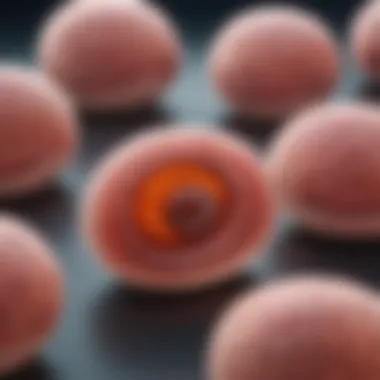Exploring the 6BB Embryo: Insights and Implications


Intro
The exploration of embryology is a critical facet of biological sciences with profound implications. Amongst the myriad of developmental stages, the 6BB embryo stands out as a notable category. This section seeks to set the foundation by defining key terms and concepts that will be explored in greater depth.
Understanding the intricate nature of 6BB embryos is essential for students, researchers, educators, and professionals who delve into reproductive biology and regenerative medicine. As we navigate this topic, we will address the characteristics, developmental phases, and ethical considerations associated with the use of 6BB embryos in research.
By providing a comprehensive review of the literature, this article aspires to facilitate discussion on the significance of this embryo stage, while also examining its potential applications and the controversies surrounding its usage in various scientific contexts.
Prelude to 6BB Embryos
The 6BB embryo has become a focal point in contemporary embryological studies. This section emphasizes the need to understand this specific type of embryo within the broader context of developmental biology and its implications in various research fields. Understanding 6BB embryos not only enlightens capacities in reproductive technology but also guides discussions in regenerative medicine and genetic engineering. Their unique characteristics distinguish them from other embryo classifications, prompting deeper inquiry into their development and potential uses.
In the realm of assisted reproductive technology, the classification of embryos is critical. The 6BB category indicates specific attributes related to cell structure and viability. Knowledge of 6BB embryos enhances success rates in procedures such as in vitro fertilization (IVF) by aiding practitioners in selecting embryos with better developmental prospects. Furthermore, the insights gained from studying these embryos extend into various scientific domains, enriching our understanding of human development and disease prevention.
Definition and Characteristics
A 6BB embryo is denoted by particular key traits that set it apart from its counterparts, such as 4BB and 8BB embryos. The classification reflects both morphological and developmental criteria. The "6BB" designation typically indicates an embryo at the blastocyst stage with a defined inner cell mass and trophoblast structure. Characteristically, these embryos display an optimal balance in cell clarity and structural integrity.
From a biological perspective, 6BB embryos demonstrate several fundamental attributes:
- Cellularity: Generally, the total cell count and arrangement are indicative of good viability.
- Blastocyst Formation: These embryos display successful transitions to the blastocyst stage, which is critical for implantation.
- Morphological Indicators: The shape and density of cells within the embryo provide insights into its overall potential for successful development.
Recognizing these characteristics facilitates discussions on their implications in medical practices and research, ultimately contributing to developments in fields such as fertility treatments and genetic research.
Historical Context
The exploration of 6BB embryos is rooted in the evolution of embryology. The classification system for embryos was established from earlier understandings derived from simple morphological evaluations. Over time, as technology and methodologies progressed, more nuanced descriptors like "6BB" emerged, refining the selection criteria for embryos used in IVF and other procedures.
Historically, embryo classification began with basic observations, yet the advent of advanced imaging techniques revolutionized this field. Enhanced visualization allowed researchers to accurately assess viability and development, setting a foundation for the recognition of 6BB embryos as a distinct category. Early studies formed foundational knowledge, gradually leading to sophisticated investigations into gene expression and developmental pathways associated with various embryo types.
In summation, the inclusion of 6BB embryos in embryology signifies a critical advancement, rooted in extensive research and technological progression. This context serves to underscore their importance and relevance in contemporary discussions of developmental biology and beyond.
Developmental Biology of 6BB Embryos
The developmental biology of 6BB embryos is a crucial area of exploration within the field of embryology. Understanding how these embryos form, develop, and differentiate provides insights not only about the embryos themselves but also about broader implications in reproductive biology and regenerative medicine. Different aspects of developmental biology apply specifically to 6BB embryos. Examining cell division, gene expression, and the physiological environment will deepen our understanding of their potential applications in research and treatment.
Cell Division and Differentiation
Cell division is a fundamental process for all living organisms. In 6BB embryos, it occurs through a series of well-regulated stages, starting from the zygote stage. As the embryo begins to divide, it transitions through early cleavage, blastocyst formation, and beyond. This progression is characterized by various factors that influence the timing and efficiency of cell division.
Differentiation is equally important. It allows embryonic cells to specialize into various cell types that will form different tissues and organs. The 6BB embryo's capacity for differentiation is notably high, indicating its robustness and potential viability. Understanding these mechanisms gives researchers clues about improving embryo quality in assisted reproductive technologies.
Interestingly, researchers have observed that external factors like the culture environment impact both division and differentiation rates. Proper conditions might encourage optimal development, suggesting implications for clinical practice.
Gene Expression Patterns
Gene expression patterns play a pivotal role in the development of 6BB embryos. During embryogenesis, specific genes are activated and silenced at precise time points, guiding the cells through their developmental pathways.
One important aspect is the role of transcription factors. These proteins interact with DNA to regulate gene activity, influencing cell fate decisions. For example, factors like Oct4 and Nanog are crucial for maintaining pluripotency in embryonic stem cells. In 6BB embryos, those genes may show unique activation and repression profiles, highlighting their developmental potential.


Moreover, understanding these patterns provides crucial insights for genetic engineering applications, like CRISPR technologies, which aim to modify gene expression for therapeutic benefits. Consequently, a comprehensive grasp of gene expression in 6BB embryos underpins many current and future scientific endeavors.
Physiological Environment and Growth
The physiological environment in which 6BB embryos grow significantly influences their development. Factors such as temperature, nutrient availability, and oxygen levels should be optimal for proper maturation. For instance, poor culture conditions can lead to arrested development or abnormal implantation.
Recent studies have explored how variations in media conditions affect embryo growth rate and cell viability. These findings offer valuable guidance for improving assisted reproductive technology outcomes.
Furthermore, the microenvironment surrounding embryos, including maternal factors, encourages effective communication between the embryo and its host. By understanding the dynamics of this environment, scientists can optimize conditions for implantation and further growth, leading to better fertility treatments.
The 6BB embryo serves as a model that encapsulates significant aspects of embryonic development, shedding light on the nuances of growth, differentiation, and regulation in early life stages.
Research Applications of 6BB Embryos
The 6BB embryo offers a unique opportunity in various fields of scientific research. Understanding its applications aids in advancing knowledge and technology in reproductive biology, genetic engineering, and regenerative medicine. Each of these domains benefits significantly from studying 6BB embryos, which provides insights that can lead to breakthroughs in treatment, prevention, and understanding of numerous biological processes.
Reproductive Biology
In reproductive biology, the 6BB embryo serves as a pivotal model for investigating early development. The embryo's characteristics allow researchers to examine cell division processes and the factors influencing successful implantation.
- Understanding Embryonic Development: By analyzing how 6BB embryos develop, scientists can learn about the intricate processes of early cell division, morphology, and physiological requirements necessary for successful gestation.
- Infertility Research: 6BB embryos may aid in identifying causes of infertility. They help evaluate how different conditions affect embryo quality and viability. Insights can lead to more effective treatments for infertility, making this research crucial for couples facing reproductive challenges.
- In-Vitro Fertilization (IVF) Advances: Techniques developed to enhance the viability of 6BB embryos can refine IVF protocols, improving success rates. For example, assessing the genetic health of embryos before implantation may optimize outcomes for patients undergoing IVF procedures.
Genetic Engineering and CRISPR
The advent of CRISPR technology presents new possibilities for manipulating genetic structures within 6BB embryos. By applying these techniques, researchers can explore diverse applications:
- Gene Function Studies: Researchers can target specific genes in 6BB embryos and study their function or role in development. This could provide insights into congenital defects and other genetic conditions.
- Modeling Diseases: Using 6BB embryos as genetic models, scientists can better understand complex diseases. This research is crucial as it allows for creating precise models to test therapies.
- Ethical Implications of Genome Editing: As genetic engineering advances, understanding the ethical implications is essential. The 6BB embryos provide a context where scientific exploration must tread carefully through ethical concerns around modification and its long-term effects.
Regenerative Medicine
Regenerative medicine is another field poised to benefit significantly from the study of 6BB embryos. The potential applications are vast and include:
- Tissue Repair and Regeneration: Insights from the 6BB embryo contribute to the understanding of how to manipulate stem cells for tissue repair purposes. Applications could lead to therapies for degenerative diseases.
- Cell-based Therapies: Development of therapies that use cells derived from 6BB embryos can address conditions like heart disease or diabetes. The focus lies in harnessing these cells to regenerate damaged tissues.
- Drug Testing: 6BB embryos can serve as models for preclinical testing of new drugs. This can significantly impact drug development, making it easier to screen for efficacy and safety before human trials.
"The exploration of 6BB embryos unlocks potential that can reshape how we approach reproductive biology, genetic engineering, and regenerative medicine."
In summary, the study of 6BB embryos is not just an academic exercise; it provides real-world applications that can change lives. Each of these research areas benefits from the unique attributes and potential of the 6BB embryo.
Ethical Considerations
Ethical considerations play a crucial role in the discourse surrounding 6BB embryos. These issues not only touch on the scientific implications but also encompass the larger societal, regulatory, and bioethical landscapes. Addressing these aspects thoroughly ensures that advancements in embryological research do not occur in a vacuum but are integrated thoughtfully into societal norms and values.
Societal Implications
The introduction of 6BB embryos raises questions about societal readiness to accept such innovations. This involves assessing public perception and understanding of embryo manipulation and its possible consequences. These implications include:
- Public Trust: Society's trust in scientific institutions can be significantly impacted by how ethical considerations surrounding 6BB research are managed.
- Reproductive Rights: The implications on reproductive choices must be considered, particularly how access to techniques involving 6BB embryos may affect equity.
- Cultural Values: Different cultures have varied beliefs regarding embryo research; understanding this diversity is crucial to ethical compliance.
From these points, it becomes clear that the societal implications of 6BB embryos are profound and far-reaching. Any research must not only value scientific integrity but also respect the societal frameworks it operates within.
Regulatory Framework


The regulatory framework governing 6BB embryo research is an essential component of ethical considerations. This framework includes:
- Local and Global Regulations: There exist varying regulations across different nations regarding embryo research. Countries like Germany and the UK have strict laws, while others may be more permissive.
- Approval Processes: Ethical review boards play a significant role in evaluating the potential risks and benefits before any research can commence.
- Informed Consent: Researchers must ensure that all participants in studies involving 6BB embryos are fully informed of the implications and risks involved. This aspect is not merely procedural but foundational to ethical research practices.
Such a robust regulatory framework is critical for preventing abuses and ensuring responsible scientific progress.
Perspectives from Bioethics
Bioethics offers a lens through which ethical considerations regarding 6BB embryos can be analyzed. Key perspectives include:
- Moral Status of Embryos: A fundamental bioethical debate centers around the moral status of embryos, particularly the 6BB type. This affects how society views the permissibility of using these embryos in research.
- Utilitarian Views: Utilitarian perspectives consider the benefits of 6BB embryo research against potential harms, pushing for a balance that emphasizes overall societal good.
- Rights-Based Approaches: Evaluating the rights of embryos, parents, and potential future human beings is vital. Such considerations can inform policies that govern embryo use.
Insights from bioethics can ensure a multidimensional understanding of the ethical climate affecting 6BB embryos, aiding in the formulation of more holistic policies and guidelines.
Ensuring ethical scrutiny in 6BB embryo research not only legitimizes scientific inquiry but also preserves public trust and further innovation in the field.
Technological Innovations in Embryology
The evolution of embryology has been significantly shaped by technological innovations. These advancements facilitate deeper understanding of embryonic development, thereby enhancing various research applications. In the context of 6BB embryos, technological innovations not only support the study of their unique attributes, but also open paths to practical applications that could benefit reproductive biology and regenerative medicine. Critical progress in imaging and biotechnology is central to these advancements.
Imaging Techniques
Imaging techniques have transformed the way scientists observe and study embryos. Traditional methods often limited the depth of observation due to restrictions in resolution and the potential for damage to live specimens. Advanced imaging modalities, such as live-cell imaging and 3D reconstruction, have emerged to address these challenges.
- Non-invasive techniques: Technologies such as time-lapse imaging allow researchers to monitor the development of embryos over prolonged periods without causing harm. This is crucial for 6BB embryos, as it improves understanding of their behavior and growth patterns in real-time.
- High-resolution imaging: Sophisticated microscopic techniques, including confocal microscopy and two-photon microscopy, provide detailed insights into cellular structures and processes. The ability to visualize cellular interactions at high magnification reveals significant information on gene expression and cellular gradients.
The ability to visualize the intricate dynamics of 6BB embryos fosters a clearer comprehension of their developmental timeframes and cellular fates, thus enhancing academic research outcomes.
Biotechnology Advances
In conjunction with imaging innovations, biotechnology has played a pivotal role in embryology, particularly concerning genetic manipulation and embryo viability assessments. Tools developed through biotechnology enable meticulous study and intervention within embryonic development.
- CRISPR technology: The advent of the CRISPR-Cas9 system has revolutionized genetic engineering. It allows for precise edits to DNA, facilitating the investigation of gene function during embryogenesis of 6BB embryos. Researchers can create models that reflect specific genetic disorders, thus providing valuable insights into the effects of targeted gene modifications.
- Stem cell research: Advances in stem cell technology contribute to understanding how pluripotent stem cells can differentiate into various cell types. Such knowledge is essential in exploring potential regenerative medicine applications using 6BB embryos. Utilizing stem cells derived from these embryos may lead to innovative therapies for conditions that currently have limited treatment options.
These biotechnology advancements are crucial in unraveling the complexities of gene interactions and the possible therapeutic applications that emerge from research on 6BB embryos.
"Technological innovations in embryology are not merely tools; they represent a paradigm shift in how research is conducted and understood within the biological sciences."
Through the integration of advanced imaging techniques and cutting-edge biotechnology, the understanding of the 6BB embryo's development and its implications continues to grow. As research evolves, so too will the methods that enhance our comprehension of embryonic biology.
Comparative Analysis with Other Embryonic Types
Understanding the Comparative Analysis with Other Embryonic Types provides vital insights into the characteristics and implications of the 6BB embryo. This analysis allows researchers to draw parallels and differences between various embryo types, facilitating advancements in embryological research. Tailoring studies to the unique attributes of each embryo type enhances clarity around their potential applications and informs researchers about best practices in reproductive and developmental biology.
Comparison with 4BB and 8BB Embryos
The 6BB embryo sits within a continuum of embryo classifications that include the 4BB and 8BB types. Each type is distinct regarding its developmental stage and viability.
- 4BB embryos are typically characterized by fewer cells and less optimal cell quality when compared to 6BB embryos. These embryos represent a developmental phase with limited potential for successful implantation due to their lower cell division rates.
- On the other hand, 8BB embryos manifest higher cell count and enhanced morphological quality. This leads to improved implantation success rates and offers greater promise in assisted reproductive technologies.


In comparing 4BB, 6BB, and 8BB embryos, it becomes clear that the 6BB type exemplifies a significant middle ground. It reflects better viability than the 4BB embryos, making it a key focus in clinical practices aiming for successful pregnancy outcomes. The active division and differentiation processes in 6BB embryos contribute to their enhanced cell development and potential applications in stem cell research.
Species Variability in Embryogenesis
The analysis of species variability in embryogenesis offers a broader understanding of how embryos develop across different biological contexts. 6BB embryos, while human-centric in many studies, present a unique opportunity to compare human embryonic development to that of other species. Each species demonstrates varying results in cell division rhythms and gene expression patterns, influencing overall viability and health.
Key points of consideration include:
- Zebrafish embryos, for example, allow for real-time imaging of developmental processes, providing insights that may lead to improved methodologies in monitoring human embryo health.
- Mouse models contribute significantly to understanding genetic and environmental impacts on embryo development and can potentially aid in identifying factors that improve or detract from 6BB embryo success rates.
Analyzing these differences is not merely academic; it lays the groundwork for translational research that could impact fertility treatments, improve genetic engineering approaches, and advance regenerative medicine. The knowledge obtained through such comparative studies is consequential, keeping in mind the dynamic biological systems in play.
The comparative approach in embryology is essential for pushing the boundaries of what is understood about embryo development and its implications in various biological fields.
Future Directions in 6BB Embryo Research
Research on 6BB embryos signifies a crucial evolution in the field of embryology. It provides an opportunity to deepen our understanding of human development and contribute to significant scientific advancements. The future directions in this area hold promise across various disciplines, allowing researchers to explore both fundamental biology and its potential applications. The significance of this research lies in its potential benefits for reproductive health and regenerative medicine, addressing fertility issues and developing novel therapies for degenerative diseases.
Emerging Trends in Research
Recent trends in the study of 6BB embryos depict a shift towards utilizing advanced technologies which enhance our understanding of embryonic development. One key focus is on in vitro fertilization techniques. As methods improve, researchers can create 6BB embryos with targeted characteristics, pushing forward the exploration of genetic manipulation.
Technological innovations, such as single-cell RNA sequencing, allow scientists to analyze gene expression at an unprecedented resolution, offering insights into cellular differentiation and developmental pathways. Moreover, artificial intelligence is beginning to play a role in predicting embryo viability and optimizing selection processes. These tools are essential as they increase success rates in reproductive technologies.
In summary, emerging technologies are facilitating collaborations across the fields of genetics, pharmacology, and bioinformatics, shaping a multidisciplinary future.
Potential Therapeutic Uses
The therapeutic applications of 6BB embryos remain a paramount focus of anticipatory research. One such application is cell therapy. Using stem cells derived from 6BB embryos could lead to breakthroughs in treating serious conditions like Parkinson’s disease or spinal cord injuries. The potential for creating genetically-compatible tissues or organs also exists, revolutionizing transplant medicine.
Additionally, drug development could benefit from studies of 6BB embryos. By understanding how embryos respond to various substances at early stages of development, researchers can optimize therapies that minimize adverse effects on embryonic development in future treatment protocols.
The integration of 6BB embryos in regenerative medicine signifies a shift toward more effective clinical applications.
"The future of 6BB embryo research offers a window into unprecedented scientific opportunities that can transform medicine as we know it."
By addressing both ongoing challenges and new horizons, researchers can harness the full potential of 6BB embryos. This work will not only enhance scientific knowledge but also provide concrete solutions to pressing health issues.
The End
The exploration of the 6BB embryo presents a multifaceted narrative that goes beyond initial scientific curiosity. It blends complexities of biology and ethical considerations, crucial in understanding contemporary reproductive techniques. This conclusion synthesizes the major points discussed in this article, emphasizing their significance moving forward.
Summary of Key Findings
In reviewing literature and current practices, we find:
- Characteristic Traits: The 6BB embryo stands out for its specific development patterns and adaptability. These features make it a vital subject in reproductive biology.
- Research Applications: The embryo's role extends into genetic engineering and regenerative medicine, indicating its potential for therapeutic application and advancements in IVF procedures.
- Ethical Frameworks: A thorough exploration of ethical implications highlights societal concerns that must be addressed when manipulating embryos, ensuring practices align with moral standards.
These findings illustrate the potential benefits of studying 6BB embryos while simultaneously calling attention to the responsibilities that researchers bear in conducting such work.
Implications for Future Research
Future research into 6BB embryos calls for a broad, yet careful approach. Important considerations include:
- Innovation in Techniques: There is room for developing new methodologies aimed at better understanding the 6BB embryos. This can lead to discoveries that might resolve current reproductive problems.
- Regulatory Policies: As the science progresses, enhanced regulations should emerge to safeguard ethical practices within the bioethical landscape. Engaging policymakers ensures that advancements respect societal values and patient rights.
- Collaboration Across Disciplines: Interdisciplinary research is encouraged. Collaborations between embryologists, geneticists, ethicists, and policy-makers can illuminate diverse perspectives, enriching the understanding of 6BB embryos.
In summary, the considerations presented herein lay groundwork that can shape future avenues of research, subsequently benefiting numerous fields and society at large.







